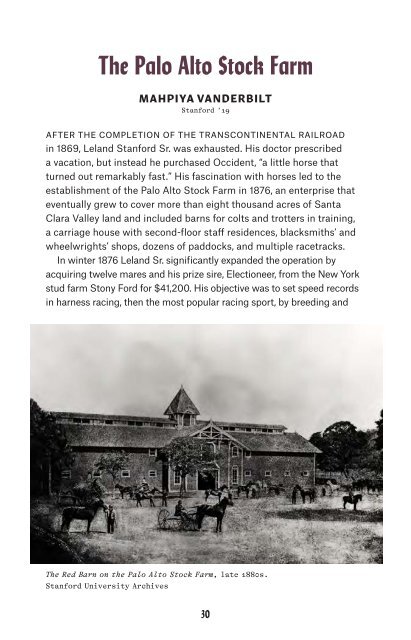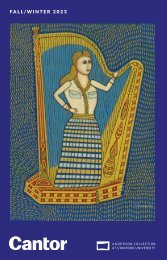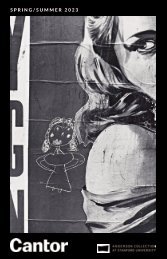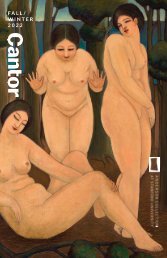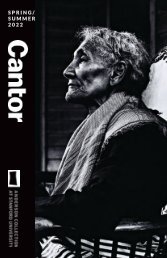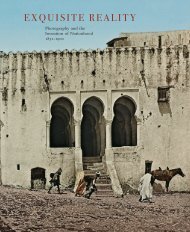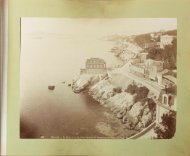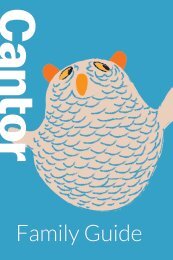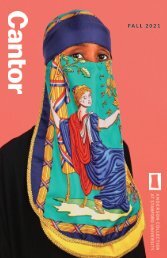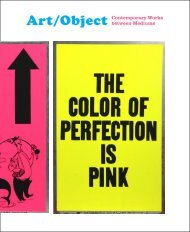Gallery Guide | The Melancholy Museum
Using over 700 items from the Stanford Family Collections, artist Mark Dion’s exhibition "The Melancholy Museum" explores how Leland Stanford Jr.’s death at age 15 led to the creation of a museum, university, and—by extension—the entire Silicon Valley.
Using over 700 items from the Stanford Family Collections, artist Mark Dion’s exhibition "The Melancholy Museum" explores how Leland Stanford Jr.’s death at age 15 led to the creation of a museum, university, and—by extension—the entire Silicon Valley.
Create successful ePaper yourself
Turn your PDF publications into a flip-book with our unique Google optimized e-Paper software.
<strong>The</strong> Palo Alto Stock Farm<br />
MAHPIYA VANDERBILT<br />
Stanford ’19<br />
AFTER THE COMPLETION OF THE TRANSCONTINENTAL RAILROAD<br />
in 1869, Leland Stanford Sr. was exhausted. His doctor prescribed<br />
a vacation, but instead he purchased Occident, “a little horse that<br />
turned out remarkably fast.” His fascination with horses led to the<br />
establishment of the Palo Alto Stock Farm in 1876, an enterprise that<br />
eventually grew to cover more than eight thousand acres of Santa<br />
Clara Valley land and included barns for colts and trotters in training,<br />
a carriage house with second-floor staff residences, blacksmiths’ and<br />
wheelwrights’ shops, dozens of paddocks, and multiple racetracks.<br />
In winter 1876 Leland Sr. significantly expanded the operation by<br />
acquiring twelve mares and his prize sire, Electioneer, from the New York<br />
stud farm Stony Ford for $41,200. His objective was to set speed records<br />
in harness racing, then the most popular racing sport, by breeding and<br />
training the best trotters in the world. By 1882 there were more than 350<br />
horses on the farm, and by 1891 approximately 750 horses, making it one<br />
of the largest training facilities in the United States. At its peak the Stock<br />
Farm employed almost 150 people, many of them Chinese immigrants,<br />
to feed, train, and care for the horses as well as maintain tracks, farm the<br />
land, and operate and repair equipment.<br />
To this day, the Palo Alto Stock Farm is renowned for its creation<br />
of a new and innovative training system to increase speed. Developed<br />
with trainer Charles Marvin, the method involved running horses in<br />
short bursts starting at a young age. After Leland Sr.’s death in 1893<br />
Jane Stanford continued the farm in her husband’s memory, but she<br />
finally closed it in 1903 and all the horses were auctioned off. Today, its<br />
legacy lives on in the university’s nickname, “<strong>The</strong> Farm.”<br />
Horse Relics<br />
ALEXANDER VEITCH<br />
Stanford ’19<br />
<strong>The</strong> Red Barn on the Palo Alto Stock Farm, late 1880s.<br />
Stanford University Archives<br />
30<br />
THE PALO ALTO STOCK FARM WAS MORE THAN MERELY THE<br />
precursor of Stanford University; it was the epicenter of a sporting<br />
empire that remains unparalleled in horse racing and beyond. <strong>The</strong><br />
farm produced California’s first celebrity athletes—equine rather<br />
than human—many of whose speed records stand unbroken today. In<br />
Leland Stanford Sr.’s estimation, the success of his racing “trotters”<br />
rivaled his achievements as a railroad magnate. Oddly enough, relics<br />
of the Stanfords’ horses expose a great deal about the new Californian<br />
elite of the Victorian era. As products of wealth and science, horses<br />
projected the status of their breeders. Leland Sr. preserved traces<br />
of his most prized horses as instantiations of his own manifest<br />
superiority. <strong>The</strong>se mementos ranged from the artistic and aesthetic to<br />
the anatomical and macabre.<br />
In 1891, the newly mounted skeleton of Electioneer, the farm’s<br />
greatest sire, was readied for display to great fanfare in the Leland<br />
Stanford Junior <strong>Museum</strong>. A horse that bred but never raced,<br />
Electioneer stood for a perfect genomic type, one that echoed the<br />
racial science of the era. After viewing the skeleton, one journalist<br />
31


